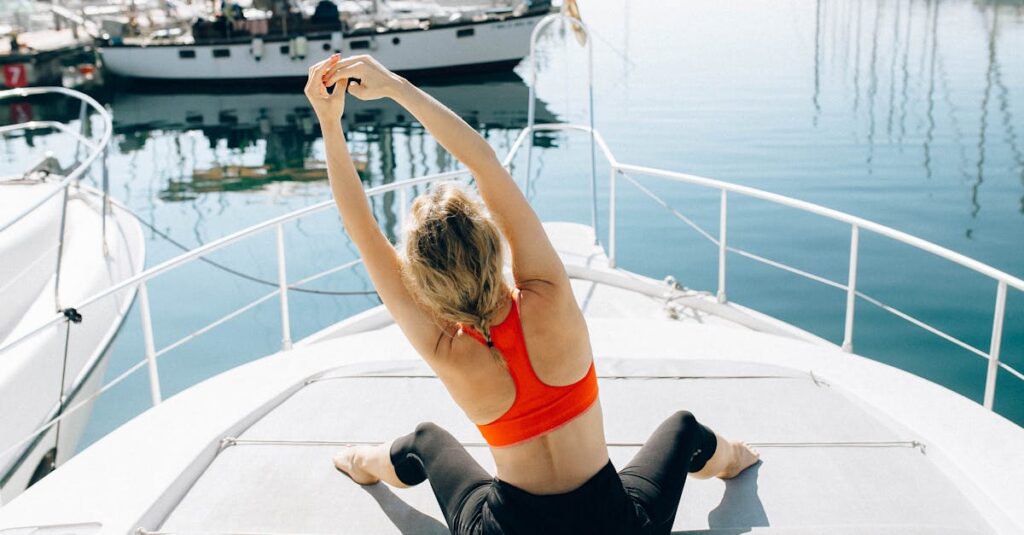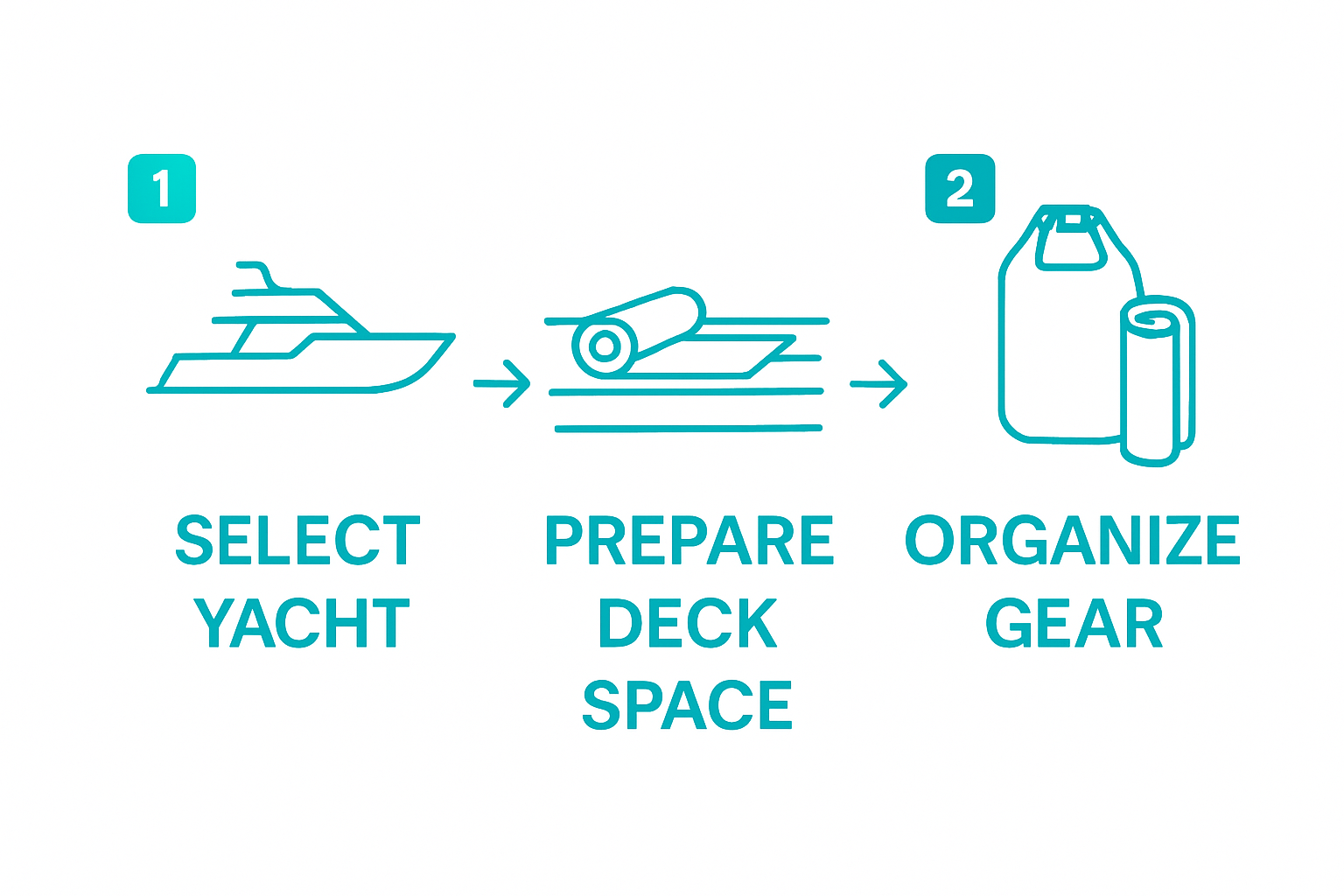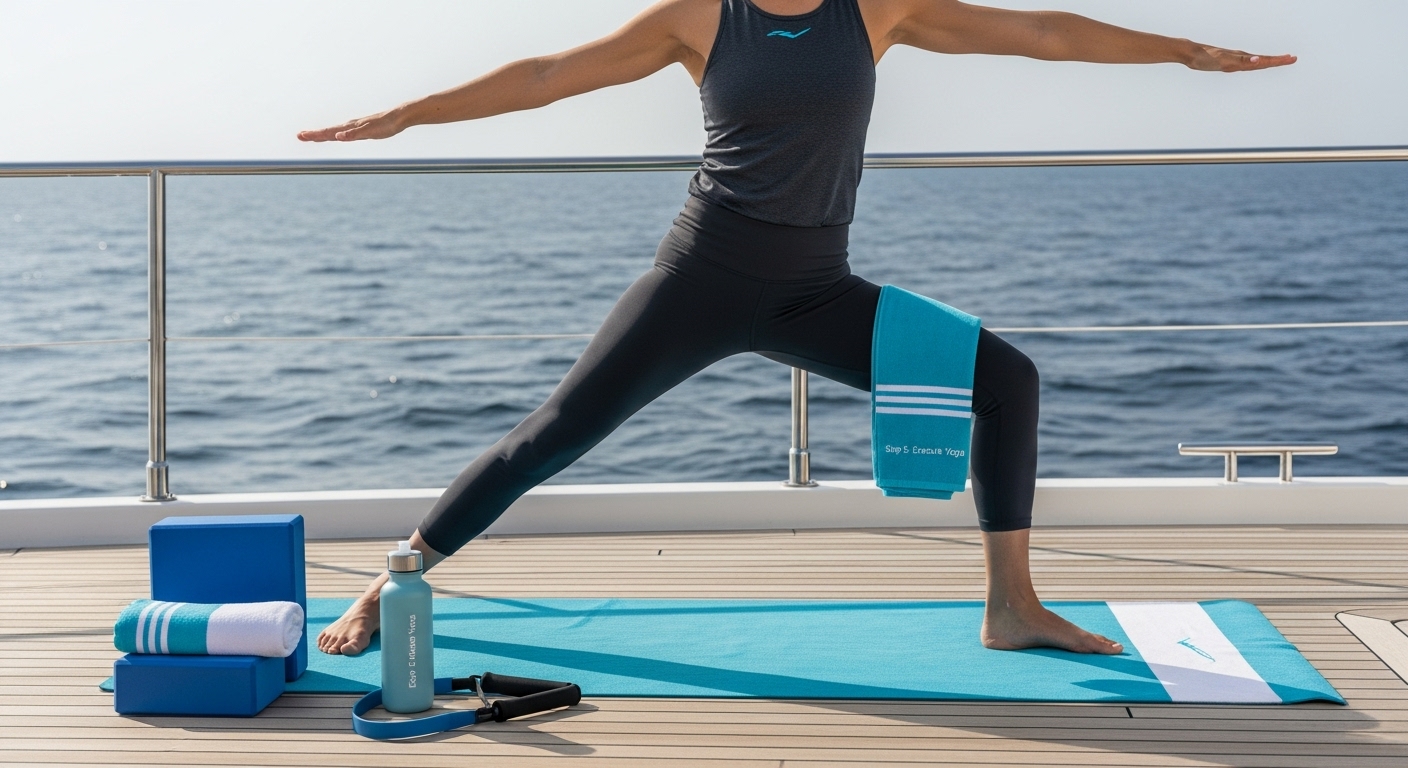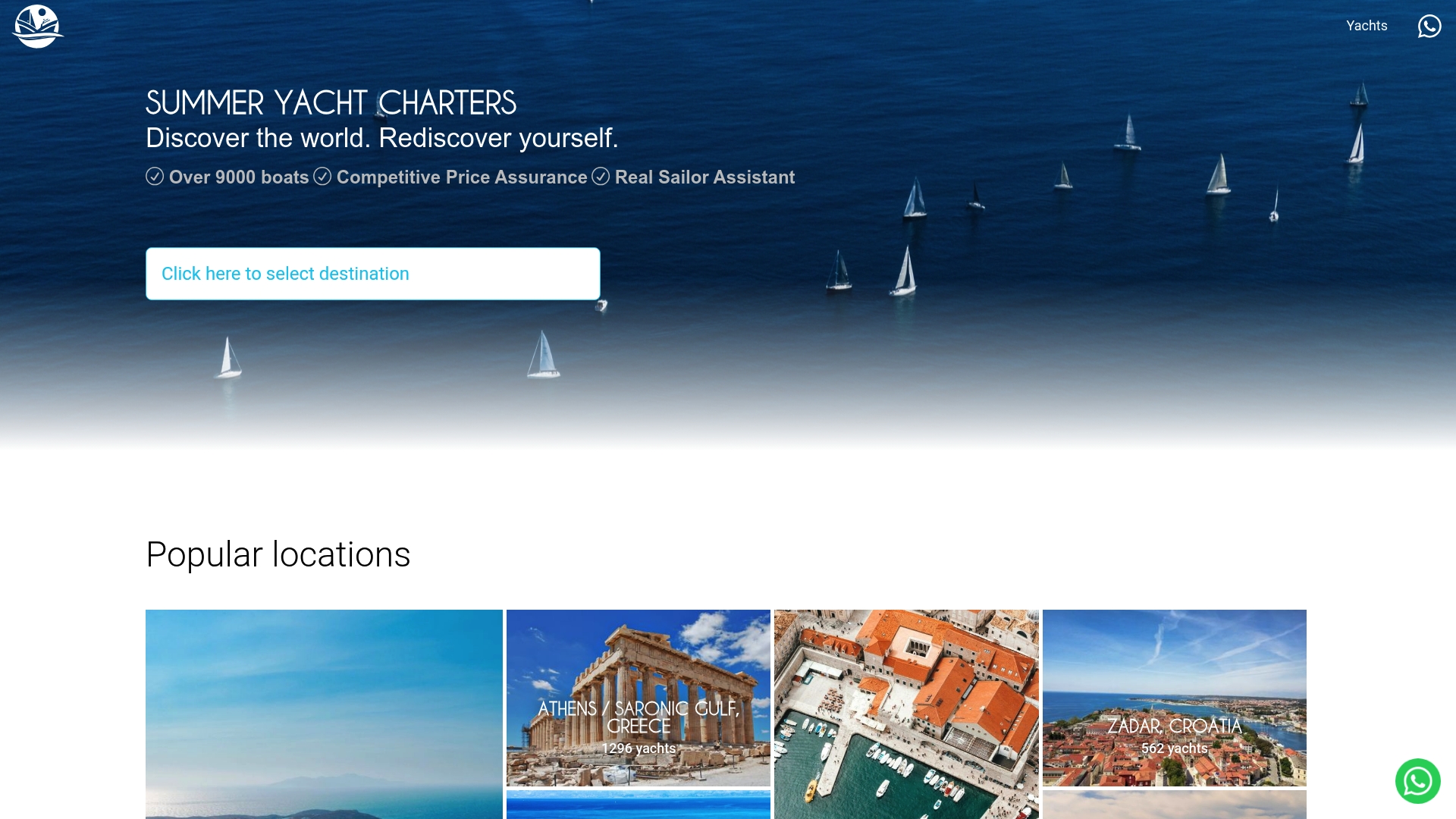Master Yoga on a Yacht: A Comprehensive Step-by-Step Guide
Learn how to expertly practice yoga on a yacht with our step-by-step guide, ensuring relaxation and balance while sailing the seas.

Practising yoga on a yacht sounds like the ultimate way to combine relaxation and adventure. People often imagine gentle stretches with the sound of lapping waves and endless views. Yet surprisingly, not every yacht is suitable for onboard sun salutations and the experience could be far less serene if you pick the wrong vessel. In fact, catamarans can offer over 3-4 square metres of safe, stable deck space for yoga and that makes all the difference. The perfect floating yoga studio is all about the right set-up, not just the view.
Table of Contents
- Step 1: Select The Ideal Yacht For Yoga
- Step 2: Prepare Your Yoga Space On Board
- Step 3: Organise Your Yoga Essentials And Gear
- Step 4: Schedule Optimal Times For Yoga Sessions
- Step 5: Execute Yoga Sessions With Precision
- Step 6: Verify Your Experience And Adjust As Needed
Quick Summary
| Key Point | Explanation |
|---|---|
| 1. Choose a stable yacht for yoga | Select vessels with expansive, flat decks for safety and stability during yoga sessions on the water. |
| 2. Create a designated yoga space | Position your mat in the most stable area, clear of obstacles, to enhance comfort and focus during practice. |
| 3. Pack lightweight, waterproof gear | Use quick-drying yoga accessories that can resist humidity and moisture, ensuring easy transport and storage. |
| 4. Schedule sessions during calm conditions | Opt for early morning or late evening sessions when the sea is calmer and the environment is more serene. |
| 5. Reflect and adjust your practice | After each session, assess your physical and mental state, making necessary modifications to improve your experience. |
Step 1: Select the Ideal Yacht for Yoga
Choosing the right yacht for your yoga practice requires careful consideration of several critical factors that will transform your maritime wellness experience. Your vessel becomes more than transportation—it becomes a floating sanctuary for physical and mental rejuvenation.
Space Configuration Matters Prioritise yachts with expansive, stable deck areas that provide ample room for yoga movements. Catamarans often offer superior stability and broader deck spaces compared to monohull vessels, making them exceptional platforms for yoga practitioners. Look for vessels with flat, unobstructed surfaces that can accommodate yoga mats and provide sufficient clearance for stretching, balancing poses, and meditation practices.
When evaluating potential yachts, assess the deck’s surface texture and dimensions. Smooth, non-slip surfaces are paramount for safety during yoga sessions. Ideal deck characteristics include:
- Minimum 3-4 square metres of uninterrupted deck space
- Low centre of gravity for enhanced stability
- Minimal structural obstacles or protrusions
- Clean, well-maintained surface material
Consider the yacht’s overall size and design. Explore our comprehensive sailing routes to understand how different yacht configurations can impact your yoga practice. Larger vessels typically provide more consistent stability, which is crucial for maintaining balance during challenging yoga sequences.
Practical considerations extend beyond physical space. Evaluate the yacht’s general amenities and environmental positioning. Morning yoga sessions benefit from east-facing decks that capture gentle sunrise light, while evening practices might prefer west-facing areas with sunset views. Natural wind protection, minimal engine vibrations, and proximity to calm waters will significantly enhance your yoga experience.
Remember that yacht selection is a personalised journey. While technical specifications matter, your intuitive connection with the vessel matters equally. Trust your instincts about how a particular yacht feels—its energy, layout, and potential for creating a serene maritime yoga environment. By selecting a yacht that resonates with your wellness goals, you transform a simple charter into a transformative holistic experience.

Step 2: Prepare Your Yoga Space on Board
Preparing your yoga space on a yacht requires thoughtful planning and strategic arrangement to transform the marine environment into a serene wellness sanctuary. This critical step bridges your physical preparation with your mental readiness, ensuring a smooth and enjoyable yoga practice amidst the gentle movements of the sea.
Equipment Selection and Positioning are paramount when establishing your onboard yoga zone. Select a lightweight, non-slip yoga mat specifically designed for maritime environments. Marine-grade yoga mats with superior grip and quick-drying materials will prevent sliding and absorb minor vessel movements. Position your mat in the most stable area of the deck, typically near the vessel’s centre where motion is minimised.
Consider the environmental conditions that might impact your practice. Early morning or late afternoon sessions typically offer the most stable conditions and most pleasant temperatures. Assess wind direction, potential spray, and sunlight exposure. Explore our sailing routes to understand how different maritime environments might influence your yoga experience.
Essential yoga accessories for maritime practice should include:
- Compact, lightweight yoga blocks
- Resistance bands
- Microfibre towel
- Water-resistant yoga strap
- Lightweight, breathable yoga attire
Preparing your space also involves creating a mental sanctuary. Clear the designated area of potential obstacles, secure loose equipment, and establish a calm mental approach. Brief communication with fellow yacht passengers ensures uninterrupted practice and mutual respect for your wellness routine.
When positioning your yoga mat, prioritise stability and comfort. Wedge the mat slightly against a secure fixture if possible, and use complementary accessories like yoga blocks to provide additional support during challenging poses. The gentle rocking of the vessel becomes an opportunity to enhance balance and core strength, transforming potential distraction into a unique yoga challenge.
Successful preparation means creating a flexible, adaptable space that respects the dynamic nature of maritime environments. Your yoga practice becomes a fluid dialogue between your body, the vessel, and the surrounding seascape—a truly transformative experience that transcends traditional yoga settings.
Step 3: Organise Your Yoga Essentials and Gear
Organising your yoga essentials for a maritime practice requires strategic planning and compact, purposeful packing. The unique challenges of practicing yoga on a yacht demand a minimalist yet comprehensive approach to gear selection and storage.
Gear Selection and Waterproofing are critical considerations when preparing yoga equipment for a maritime environment. Choose lightweight, quick-drying materials that can withstand potential sea spray and humidity. Opt for compact, multipurpose yoga accessories that serve multiple functions while minimising storage requirements. Explore our sailing routes to understand how different maritime environments might influence your equipment choices.
Your essential maritime yoga kit should include:
- Microfibre yoga mat with superior grip
- Collapsible yoga blocks
- Lightweight resistance bands
- Waterproof dry bag for equipment storage
- Compact, quick-drying towel
Storage Solutions and Organisation become paramount in the limited space of a yacht. Invest in waterproof, compact storage containers that can be securely fastened to prevent movement during sailing. Vacuum-sealed bags can compress clothing and smaller accessories, maximising available storage space. Consider multi-functional gear that can serve both yoga and general maritime purposes.
Prioritise accessibility and protection of your yoga equipment. Create a dedicated, secure storage area that shields items from moisture and potential damage. Use water-resistant containers with tight-sealing lids, and consider using silica gel packets to absorb excess moisture. Arrange your gear in a manner that allows quick access while maintaining a neat, organised approach.
Mental preparation is equally important as physical organisation. Develop a systematic approach to unpacking and setting up your yoga space. Create a consistent routine for preparing your gear, which helps maintain mindfulness and reduces stress. Your organisation strategy should focus on efficiency, allowing you to transition smoothly from sailing to yoga practice without unnecessary complications.
Ultimately, successful gear organisation transforms your yacht into a floating wellness sanctuary. By carefully selecting, protecting, and arranging your yoga essentials, you create a seamless environment that supports both your maritime adventure and your personal wellness journey.
To facilitate packing and preparation, here is a table summarising the essential yoga gear for maritime practice, along with specifications and practical usage notes.
| Item | Specification/Feature | Purpose/Usage |
|---|---|---|
| Microfibre yoga mat | Superior grip, quick-drying | Prevents slipping, resists moisture |
| Collapsible yoga blocks | Lightweight, compact | Additional stability and support |
| Resistance bands | Lightweight, flexible | Assists with stretching and strength |
| Waterproof dry bag | Durable, moisture-resistant | Secure storage for equipment |
| Quick-drying towel | Compact, microfibre material | Absorbs moisture, easy to pack |
| Water-resistant yoga strap | Adjustable, dries quickly | Aids in deeper stretches |
| Lightweight attire | Breathable, quick-drying | Comfort during practice |
Step 4: Schedule Optimal Times for Yoga Sessions
Scheduling yoga sessions on a yacht requires a nuanced approach that harmonises with maritime rhythms, vessel movements, and natural environmental conditions. Your timing becomes as crucial as your technique, transforming a simple practice into a holistic maritime wellness experience.
Morning Sessions: Embracing Dawn’s Tranquility represent the most recommended time for yacht-based yoga. The early morning offers unparalleled serenity—minimal wind, calm waters, and soft ambient light create an ideal setting for mindful practice. Position yourself facing east to absorb the emerging sunlight, allowing the gentle morning sea breeze to guide your breath and movements. These sessions become a powerful ritual of connection between your body, the vessel, and the surrounding marine environment.
Consider these strategic timing considerations:
- Sunrise yoga (30-60 minutes after dawn)
- Before breakfast preparation
- When sea conditions are typically most stable
- Prior to daily sailing activities
Evening Sessions: Sunset Meditative Practices provide an alternative yoga window that capitalises on the day’s accumulated energy and approaching maritime tranquillity. As sailing routes wind down and vessel activities decrease, you can leverage the golden hour for restorative and meditative yoga sequences. The gradually softening light and cooling temperatures create a natural relaxation environment that supports gentle stretching and mindfulness.
Navigate potential challenges by remaining flexible with your schedule. Maritime conditions can change rapidly, so develop a practice that adapts to varying environments. Wind intensity, vessel stability, and crew activities might necessitate impromptu adjustments to your planned yoga time. Cultivate a mindset of adaptability—your yoga practice should complement the yacht’s rhythm, not compete with it.
Ultimately, successful yoga scheduling on a yacht is about attunement—listening to the vessel, respecting environmental conditions, and aligning your practice with the natural maritime flow. By understanding and working with these dynamic elements, you transform yoga from a structured routine into an intuitive, responsive experience that celebrates the unique intersection of wellness and maritime adventure.
Step 5: Execute Yoga Sessions with Precision
Executing yoga sessions on a yacht demands a unique blend of technical skill, bodily awareness, and maritime adaptability. Your practice becomes a dynamic dialogue between personal movement and the vessel’s natural rhythms, requiring heightened concentration and nuanced physical intelligence.
Foundational Stability and Alignment are paramount when practicing yoga in a maritime environment. Begin by establishing a wide, grounded stance that compensates for potential vessel movement. Engage your core muscles more intensively than during land-based practice, using micro-adjustments to maintain balance. Focus on creating a strong, stable base by slightly widening your stance and keeping your centre of gravity low. Knee-soft positioning and engaged abdominal muscles will help you navigate the subtle shifts of the yacht’s deck.
Key maritime yoga execution strategies include:
- Prioritise slower, more controlled movements
- Use yoga blocks for additional stability
- Modify traditional poses to accommodate maritime conditions
- Maintain constant awareness of vessel movement
Adapt your practice by selecting yoga sequences that complement maritime dynamics. Explore our sailing routes to understand how different marine environments might influence your practice. Standing balance poses like Warrior sequences and modified Tree poses work exceptionally well, allowing you to develop enhanced proprioception and muscular engagement.
Breath control becomes your primary mechanism for maintaining precision. Synchronise your breathing with the yacht’s natural movement, using rhythmic pranayama techniques that help stabilise both your internal state and external balance. Deep, controlled breathing not only supports your physical practice but also cultivates mental resilience against potential disorientation caused by maritime motion.
Remember that imperfection is part of the maritime yoga experience. The unpredictable nature of sailing means your practice will never be identical to land-based yoga. Embrace the dynamic environment as an opportunity to develop enhanced body awareness, flexibility, and mental adaptability. Each subtle shift of the deck becomes a teacher, challenging you to refine your practice and deepen your connection with both your body and the marine environment.

Step 6: Verify Your Experience and Adjust as Needed
Verifying and refining your yacht yoga practice requires a holistic approach that integrates physical feedback, mental reflection, and adaptive strategies. This final step transforms your maritime yoga experience from a structured routine into a personalised, evolving wellness journey.
Physical Assessment and Sensory Feedback become your primary verification tools. Immediately after each yoga session, conduct a comprehensive body scan to evaluate how maritime yoga impacts your physical condition. Pay attention to muscle tension, balance, flexibility, and any unexpected sensations unique to practicing on a moving vessel. Body awareness is your most sophisticated instrument for understanding the nuanced interactions between your practice and the marine environment.
Key self-verification criteria include:
- Muscle symmetry and tension levels
- Overall physical comfort and stability
- Breath quality and respiratory ease
- Mental clarity and emotional state
Mental reflection complements physical assessment. Explore our sailing routes to understand how different maritime environments might influence your practice’s psychological dimensions. Document your experiences through brief journaling, capturing not just physical observations but also emotional and mental shifts triggered by your yacht yoga practice.
Adjustment strategies should be flexible and responsive. If certain poses prove challenging due to vessel movement, modify your approach by reducing pose complexity, using additional support tools, or selecting alternative sequences that better match maritime conditions. Develop a mindset of curiosity and experimentation, viewing each yoga session as a unique opportunity for discovery rather than a fixed performance metric.
Technological and Observational Tools can enhance your verification process. Consider recording brief video segments of your practice to analyse your form, balance, and adaptability. Review these recordings objectively, treating them as valuable learning resources that provide insights into your maritime yoga evolution. Remember that imperfection is not a weakness but a natural component of practicing yoga in a dynamic, unpredictable environment. Your ability to adapt, reflect, and refine becomes the true measure of your maritime yoga mastery.
To help you evaluate your sessions and make improvements, the following table provides a concise checklist of physical and mental verification steps after each yacht yoga practice.
| Verification Step | Key Focus/Question | Adjustment Action if Needed |
|---|---|---|
| Assess muscle tension/symmetry | Are any areas unusually tense or unbalanced? | Modify poses or integrate extra stretches |
| Check overall physical comfort | Are you comfortable and stable post-session? | Use more support gear, adjust mat placement |
| Evaluate breath quality | Was your breathing deep and controlled? | Slow down practice, add breathwork focus |
| Note mental/emotional state | Do you feel clear-minded and emotionally balanced? | Journal reflections, adjust session length |
| Review balance and adaptability | Did you manage vessel movement well? | Select easier poses, refine core engagement |
Unlock Your Floating Yoga Sanctuary With Summer Yacht Charters
If you are inspired by the idea of practising yoga at sea but feel uncertain about how to find the perfect yacht, route, or onboard set-up, you are not alone. Many travellers want to transform a simple sailing getaway into a wellness experience yet worry about issues like inadequate deck space, yacht stability, and finding the right atmosphere for mindful sessions. This is where expert planning and tailored itineraries make all the difference.
Start exploring handpicked sailing itineraries designed for ultimate tranquillity and wellness.

Ready to find the yacht that truly supports your yoga practice and relaxation goals? Discover how Summer Yacht Charters simplifies everything, from vessel selection with stable decks, to flexible routes through the Ionian islands, and expert support every step of the way. Book now to secure exclusive access to our curated fleet and receive a personalised journey for mind and body. Your floating yoga retreat starts with one simple step.
Frequently Asked Questions
What type of yacht is best for yoga practices?
Choosing a yacht with a stable deck, such as a catamaran, is ideal for yoga. Look for vessels with a minimum of 3-4 square metres of unobstructed deck space, low centre of gravity, and non-slip surfaces to ensure safety and comfort during your practice.
How should I prepare my yoga space on a yacht?
To prepare your yoga space, select a lightweight, non-slip mat and position it in the most stable area of the deck. Consider equipment like blocks and resistance bands, and create a calm atmosphere by removing obstacles and communicating your practice schedule with fellow passengers.
What essential gear do I need for yoga on a yacht?
Your maritime yoga kit should include a microfibre yoga mat, collapsible blocks, resistance bands, a waterproof dry bag for storage, and a quick-drying towel. Opt for lightweight, compact materials that are suitable for a marine environment.
When are the best times to schedule yoga sessions on a yacht?
The best times for yoga on a yacht are typically early morning and late afternoon. Morning sessions benefit from calm waters and soft light, while evening practices allow for tranquil conditions and cooler temperatures as the day winds down.
Recommended
- Promo7 – Summer Yacht Charters
- Summer Yacht Charters for Unforgettable Adventures
- Special Offer Questionnaire – Summer Yacht Charters
- ITINERARIES Archives – Summer Yacht Charters